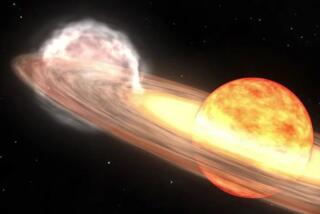After 600 years, astronomers crack the case of an exploding star
- Share via
A team of researchers has discovered the source of a stellar explosion that was first documented by Korean astronomers nearly 600 years ago.
The pinpointing of the binary star system that birthed Nova Scorpii 1437, described in the journal Nature, solves a centuries-long mystery and sheds new light on the nature of stars whose surfaces explode.
One night in the year 1437, astronomers in Seoul noticed a new star that had appeared out of nowhere, sitting in the tail of the constellation Scorpius. It lasted for 14 days before fading away. The observers who documented it in the Sejong Sillok — the Veritable Records of King Sejong, who ruled Korea from 1418 to 1464 — called it a “guest star.”
This was not a new star, but a nova — an explosion caused by superheated material gathering around a white dwarf. A white dwarf is a stellar corpse — the remnant of a dying star that has already sloughed off its outer layers, leaving behind a small, dense core. But when a white dwarf is in a binary system with a normal star, that stellar corpse becomes a stellar zombie, gobbling up material pulled from its normal companion. That stolen star-stuff gets sucked into an accretion disk around the white dwarf, and eventually ends up on its surface.
As that additional mass builds up, the rising pressure and temperature trigger a runaway nuclear reaction. The resulting thermonuclear explosion hurls off that extra star-stuff from the white dwarf’s surface, creating a nova that can, briefly, be up to a million times brighter than usual.
White dwarfs can only handle so much mass — up to the Chandrasekhar Limit, about 1.4 suns’ worth — beyond which they would collapse. But this process acts a little like a safety valve, allowing the white dwarf to hurl off that stolen star stuff and start siphoning more away from its binary companion again.
These particular binary star systems, also known as cataclysmic variables, can do this over and over, for a very long time — or so researchers think. But astronomers haven’t been around long enough to see this cycle in action, said lead author Michael Shara, a curator in the American Museum of Natural History’s department of astrophysics.
“In 100,000 years, we’ll certainly have had the opportunity to check on all of the dwarf novas that we know of in the sky, watch them go into nova eruptions, and hopefully watch them fade back into dwarf novae,” Shara said. “But I don’t have that kind of time.”
That’s why the historical record of such events, like the one documented by Koreans nearly six centuries ago, can be so useful to researchers like Shara.
The problem is, it’s very hard to match up the historical record to the stars we see today. That’s because the white dwarf and its companion star would have moved away from the nova’s center in the meantime.
Scouring the Scorpio system, Shara and his colleagues identified a shell-like structure (a possible nova remnant) as well as a star system that was no longer dead center but could potentially have been the source. He and his colleagues then dug into more recent archives — photographic plates from 1923 taken by the Harvard Observatory station in Peru, now available online.
By tracking how much the binary star system had moved over the last century, the researchers could then figure out how far it must have moved over the last 600 years. That system’s position turned out to match the Korean astronomers’ description.
“Astronomy is concerned with both the large scale and the long term, and historical observations are often important for resolving evolutionary questions,” Steven Shore of the University of Pisa, who was not involved in the research, wrote in a commentary. “In this case, Shara and colleagues’ identification of the cataclysmic variable associated with Nova Scorpii 1437 is a lovely piece of historical scholarship.”
Other photographic plates from the 1940s showed that the white dwarf binary system had behaved like a dwarf nova in the 1930s and 1940s, Shore said. Astronomers had puzzled over dwarf novae, wondering how they were related to classical novae. The new study shows that dwarf novae and full novae are one and the same — just at different stages in their cycle.
It also shows that these white dwarfs can start building up mass at a good clip pretty soon after going nova, Shore added.
“How novae affect the long-term development of cataclysmic variables and how much of the accreted gas is expelled by the explosion can be understood only by discovering systems that are in temporary retirement,” Shore wrote. “Shara and colleagues’ study provides the key to finding these systems in our Galaxy.”
Follow @aminawrite on Twitter for more science news and “like” Los Angeles Times Science & Health on Facebook.
MORE IN SCIENCE
Catastrophic storms, once rare, are almost routine. Is climate change to blame?
NASA’s Cassini spacecraft nears a fiery, brutal end, when it will plunge into Saturn
UPDATES:
Sept 3, 12:12 p.m.: This story was updated with a comment from lead author Michael Shara.
This story was originally published August 31 at 7:35 p.m.







